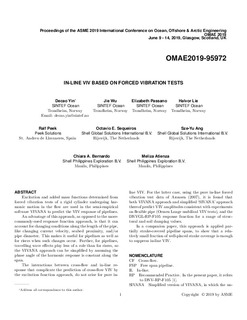| dc.contributor.author | Yin, Decao | |
| dc.contributor.author | Wu, Jie | |
| dc.contributor.author | Passano, Elisabeth | |
| dc.contributor.author | Lie, Halvor | |
| dc.contributor.author | Peek, Ralf | |
| dc.contributor.author | Sequeiros, Octavio E. | |
| dc.contributor.author | Ang, Sze | |
| dc.contributor.author | Bernardo, Chiara | |
| dc.contributor.author | Atienza, Meliza | |
| dc.date.accessioned | 2020-01-21T08:25:08Z | |
| dc.date.available | 2020-01-21T08:25:08Z | |
| dc.date.created | 2020-01-20T11:55:22Z | |
| dc.date.issued | 2019-06-14 | |
| dc.identifier.citation | ASME 2019 38th International Conference on Ocean, Offshore and Arctic Engineering (OMAE2019): Volume 2: CFD and FSI | nb_NO |
| dc.identifier.isbn | 978-0-7918-5877-6 | |
| dc.identifier.uri | http://hdl.handle.net/11250/2637126 | |
| dc.description.abstract | Excitation and added mass functions determined from forced vibration tests of a rigid cylinder undergoing harmonic motion in the flow are used in the semi-empirical software VIVANA to predict the VIV response of pipelines. An advantage of this approach, as opposed to the more-commonly-used response function approach, is that it can account for changing conditions along the length of the pipe, like changing current velocity, seabed proximity, and/or pipe diameter. This makes it useful for pipelines as well as for risers when such changes occur. Further, for pipelines, travelling wave effects play less of a role than for risers, so the VIVANA approach can be simplified by assuming the phase angle of the harmonic response is constant along the span. The interactions between cross-flow and in-line response that complicate the prediction of cross-flow VIV by the excitation function approach, do not arise for pure inline VIV. For the latter case, using the pure in-line forced vibration test data of Aronsen (2007), it is found that both VIVANA approach and simplified ‘SIVANA’ approach thereof predict VIV amplitudes consistent with experiments on flexible pipe (Ormen Lange umbilical VIV tests), and the DNVGL-RP-F105 response function for a range of structural and soil damping values. In a companion paper, this approach is applied partially strake-covered pipeline spans, to show that a relatively small fraction of well-placed strake coverage is enough to suppress in-line VIV. | nb_NO |
| dc.language.iso | eng | nb_NO |
| dc.publisher | ASME Press | nb_NO |
| dc.relation.ispartof | ASME 2019 38th International Conference on Ocean, Offshore and Arctic Engineering (OMAE2019): Volume 2: CFD and FSI | |
| dc.relation.ispartofseries | ASME Digital collection;OMAE2019-95972 | |
| dc.rights | Attribution-NonCommercial-NoDerivatives 4.0 Internasjonal | * |
| dc.rights | Attribution-NonCommercial-NoDerivatives 4.0 Internasjonal | * |
| dc.rights.uri | http://creativecommons.org/licenses/by-nc-nd/4.0/deed.no | * |
| dc.title | In-Line VIV Based on Forced-Vibration Tests | nb_NO |
| dc.type | Chapter | nb_NO |
| dc.description.version | acceptedVersion | nb_NO |
| dc.identifier.doi | 10.1115/OMAE2019-95972 | |
| dc.identifier.cristin | 1777519 | |
| cristin.unitcode | 7566,7,0,0 | |
| cristin.unitname | Energi og transport | |
| cristin.ispublished | true | |
| cristin.fulltext | postprint | |
| cristin.qualitycode | 1 | |

